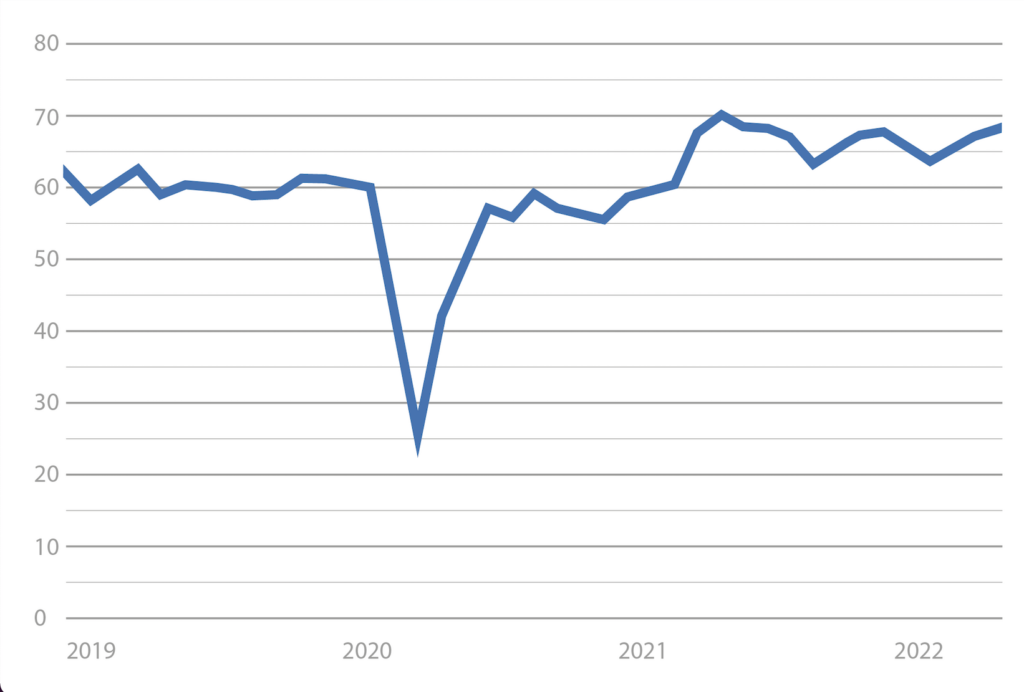Why Big Ecommerce’s Pause is a Blip in the Supply Chain Story
Recent headlines paint a dramatic picture of warehouse upheaval as the world recalibrates from the e-commerce boom and prioritizes post-lockdown experiences over products.
The data’s response? Meh.
Undoubtedly, Amazon’s announcement in mid-May that it would shed space, at least 10 million square feet, created waves—in markets and among owners of logistics real estate. Other big-name retailers sparked chatter with proclamations about inventory in the wrong product categories.
Contrary to some foreboding buzz, the industrial real estate market’s growth held firm in April, extending the momentum of a robust first quarter sales—rising imports lifted results. Overall, the data representing how warehouse customers have so far acted presents a story that’s headed in the opposite direction from headlines about an e-commerce behemoth’s bearish moves.
Prologis’ research highlights a need for logistics customers to expand inventories to meet consumer demand and improve resilience as the economy recovers, coupled with a need for logistics companies to build more space for customers to lease. At the end of Q1, the vacancy rate in the U.S., 3.2%, was an all-time low. Given supply-demand dynamics at the time, the U.S. was on track to run out of available logistics space in just six months. That precise interplay of supply and demand is captured in a new metric that Prologis introduced in Q1, the True Months of Supply (TMS)™. The next TMS is planned for release at the end of Q2.
Of course, that dynamic—and Prologis’ recommendations—could change if retail sales growth further slows and the U.S. enters a downturn, as some economists predict. But so far, the big picture is far more optimistic than the buzz might have you believe. Here are the key details from our numbers:
If you only remember three things…

1. People are buying more stuff, and supply chain bottlenecks are easing. Imports from China jumped 12.7% in April, combined with an 0.8% rise in nominal seasonally adjusted core retail sales. Prologis’s IBI, our industrial business activity index, rose to 68.3 from 67.4 the prior month and 65.4 at the end of Q1 2021 (greater than 50 indicates growth, demonstrating we’re well within growth territory). The increase is a key forward indicator of logistics real estate demand across the U.S.
2. E-commerce isn’t going anywhere—it’s diversifying. Prologis leasing data shows that in the year through Q1 2022, non-Amazon customers accounted for 85% of new e-commerce leases, up from 66% in 2020.
3. Our advice for those wanting warehouse space: Plan ahead. An extremely low vacancy rate, historic low in True Months of Supply (TMS)™ and high utilization rate (85.6%), means the pandemic-era space race isn’t slowing down.
Bottom line, Amazon is the undisputed heavyweight champ of e-commerce, often defining strategy for an entire industry. The move of one e-commerce giant, however, does not encompass the entire story of the U.S. logistics real estate market nor does it indicate a changing tide in the broader supply chain.
Think of this moment like the one in September 2021 when headlines blasted news about a second massive cargo ship stuck in the Suez Canal. Just six months earlier, the Ever Given ran aground in the canal for six days, wreaking havoc up and down the supply chain. This time, despite the seemingly symbolic images of another giant vessel sitting askew in an infamous bottleneck, the ship was freed in about 15 minutes.



